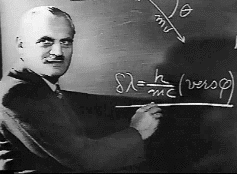A laser beam is a ray of light with high intensity generated through the stimulated emission of photons ("light particles"). In 1916 Albert Einstein proposed that despite not having a mass (their mass is zero), photons nonetheless have momentum and are thus theoretically capable of redirecting particles with which they collide (and transfer their momentum to them).
Several years later, in 1922, physicist Arthur Compton performed an experiment which led to the discovery of the Compton Effect. Proving Einstein correct, Compton showed that photons indeed have momentum which is transferrable to materials that have a mass. Compton was awarded the 1927 Noble Prize in Physics for demonstrating that photons can transfer their momentum to the electrons with which they collide inside an atom.

But how powerful can light actually be? Using the photon momentum formula (which is a constant divided by the wavelength of the light wave) and the energy of the photon (a constant multiplied by the speed of light, divided by the wavelength), it can be easily demonstrated that the pressure applied by a light beam on the surface at which it is directed is simply the intensity of the light (in watts per unit area) divided by the speed of light. Since the speed of light is quite a large number (300 thousand kilometers per second), the above equation implies that the light beam applies very little pressure on surfaces. Think of the following example to appreciate just how small the pressure applied by light is: The sun illuminates Earth at an intensity of 1,370 watts per square meter. Thus, the pressure applied by the photons is given by the formula 108 x 1370 / 3 = 4.57 micro-newtons per square meter. This means that a square surface of 1000 meters by 1000 meters is subject to a pressure of 4.57 newtons from the sunlight. This is equivalent to approximately 450 grams – less than a small soda bottle!
The intensity of the strongest laser in the world is 1.1 million watts. Were we to assume that the area of a cross section of the beam is 1 cm2, the photon pressure would be equivalent to only 366 mg – less than an over-the-counter pain killer tablet. And this is the world's strongest laser...
In summary, it is currently impossible, and will probably remain so in the future, to generate a laser beam intense enough to counter the momentum of an asteroid, a mass of rock and ice that travels in space and can reach a mass of several tons.

But is it necessary to generate an opposing force when there is so much energy? While the world's strongest laser can't even budge a small pill, in truth any material hit by such a beam would instantly warm up to a temperature of 100 million degrees and turn into vapor and even plasma (atoms that lost some of their electrons). And since all of this would occur in a fraction of a second due to the high energy involved, it's fair to assume that anything hit by the beam would actually explode! And this is no science fiction…

The advantage of using a laser for shooting down objects is the vast speed of light: even an object that is 400 km (250 miles) away from us would explode the moment the laser is sent (the time it takes the light to reach the object is negligible - about 1 millisecond). That is to say, exploiting the high energy density of the laser (rather than the force exerted by the photons) could be a potential method for intercepting asteroids: blowing them up into small pieces that cannot cause significant damage, even if they manage to enter Earth's atmosphere without burning and reach the ground.
An alternative solution would be to use a laser 'tractor beam'. For the meanwhile this term appears only in science fiction films and books in the context of large objects. Microscopic objects, however, have been manipulated with 'optical tweezers' – an instrument that uses a highly focused laser beam to grasp and even move around micron-size particles. In March 2011 it was even reported that scientists managed to use optical tweezers to manipulate atoms and molecules.
In summary, the pressure applied by even the strongest of lasers is negligible considering the mass of an asteroid, and therefore cannot provide a solution. The energy of light, however, may prove to be of great value, even with today's technologies. Further ahead in time, we may see the development of a laser-based tractor beam that can manipulate large masses, and not only microscopic objects like nowadays.
